Notes from Our 10th Anniversary Party/Meeting on July 30, 2021
It was great to get back to an in-person event after a long 17 months of Zooming. Dean, Keith, Phil, Hank and I were present. This was our 76th meeting. We were celebrating our 10th anniversary of meetings. The first one was on July 21, 2011.
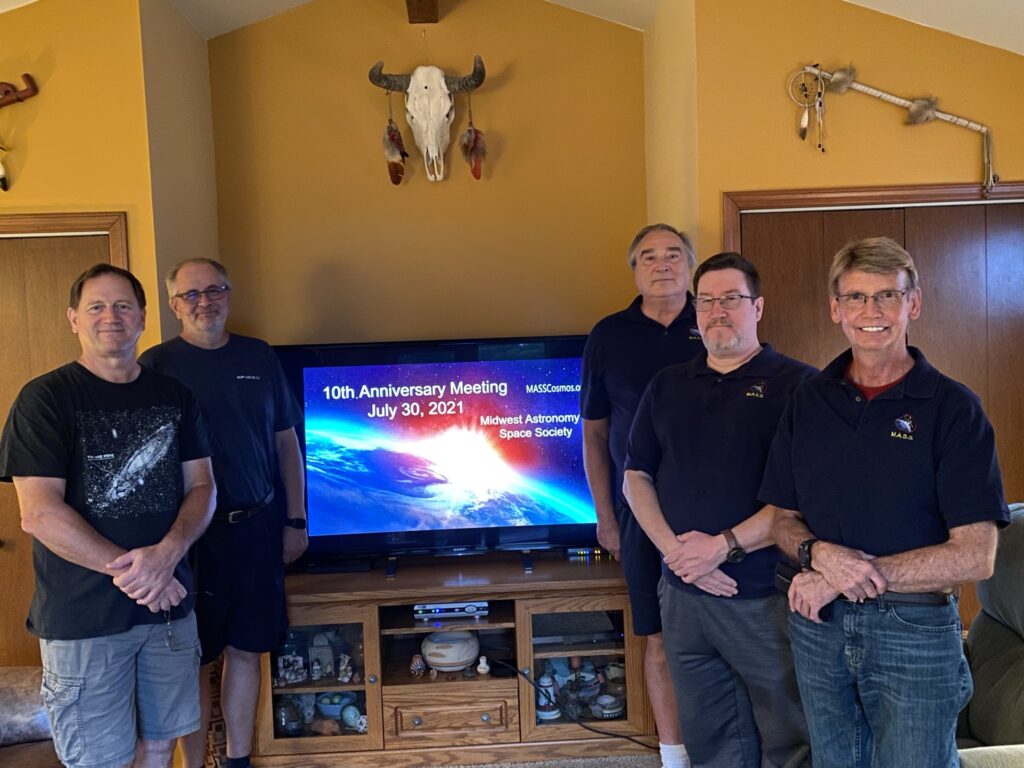
I started off by displaying the pile of notes from the previous 75 meetings. The group estimated that is was about a ream and a half thick pile of paper. I also shared my half sheet of notes from our first meeting. Topics included discussion of the last Shuttle flight, the upcoming announcement of NASA’s unnamed heavy lift rocket (soon to called SLS), and the 4 companies vying for Commercial Crew vehicles. Blue Origin and Sierra Nevada would eventually be eliminated and SpaceX with their Crew Dragon and Boeing with their CST-100 or Starliner would be chosen to fully develop their designs.
Here is what the group looked like at one of our early meetings,
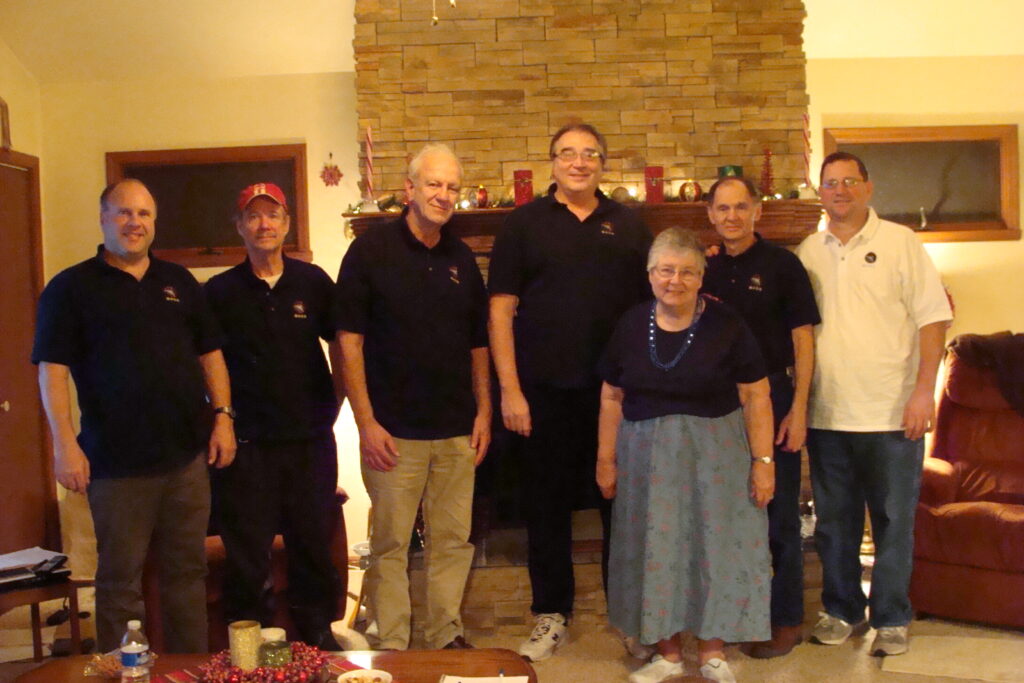
Our MASS roots go back to Villa Park library lectures, where I first met Dean, Phil, Harry, Judy, Ed and Beth, Triton College SkyWatch events, where I met Silvio, Jim A. and his wife Sophia, Dean’s Triton astronomy/space classes, where I met Dave and National Space Society meetings in Schaumburg, where I met Keith and Jim P. Beth’s husband, Chad, also joined us at meetings as well as Keith’s friend, Hank. Other memories were our Pluto Palooza Party on July 17, 2015 to celebrate New Horizons’s flyby of the planet and the Apollo 50th Celebration on July 19, 2019.
Thanks to Dean for the design of our MASS logo. I can always help members order merchandise from VistaPrint including shirts, sweatshirts and caps, etc. Thanks also to Kevin Cole, astronomer at Triton and Harper College, for coming up with our name, MASS (Midwest Astronomy and Space Society). I was a little hesitant to use the term Midwest since we only had members in the Western suburbs of Chicago. But what the heck, go for it!
Thanks also to Keith for MASS’s Internet presence. Our website MASScosmos.org is very impressive with numerous up-to-date news feeds. He also enabled our video component by recording and posting our Zoom meetings on YouTube. Our Facebook site is up to 232 members! Great job!
Prelims
I made a quick award of 3 Mars bars to Dean for the closest guess for how deep the “mole” on the Mars Insight mission burrowed. Dean had the most pessimistic guess of the group at 42 inches. Because the Martian soil tended to stick together, the mole didn’t get the friction needed to get very deep. Scientists gave up with the mole at a sharp angle with the surface and only about 14 inches down. Unfortunately, scientists needed a depth of at least10 feet to get good data about how much heat was coming from Mars’ core. On the positive side, the seismic instrument has been measuring Mars quakes and scientists have recently announced that they think Mars has a liquid core about half of its diameter. This is much larger than was originally theorized.

I mentioned to the group that the peak of Perseid meteor shower will occur on the night of August 11-morning of August 12. Viewing will be difficult with Chicago’s sky glow and the haze from the forest fires but I might still take out my zero-gravity chairs to try to catch a couple of fleeting streaks at 2 AM. My granddaughter, Cara, has expressed some interest and maybe I can get her interested in “watching the skies.” I couldn’t resist showing the group a picture of one of our new plants, the tall purple one in the center is called “meteor shower”.
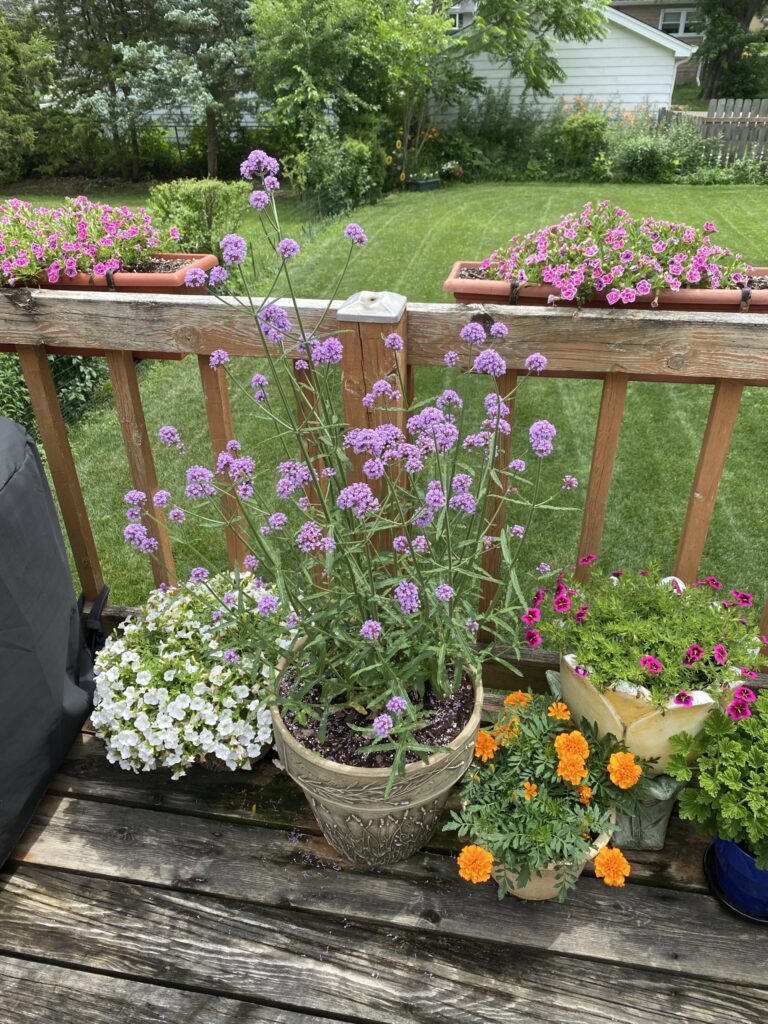
I also showed my Pluto picture puzzle. I glued it together even though it has 80 pieces of solid black missing. Several attempts to complete it had me so frustrated that I never wanted for another person or myself to experience the utter despair of trying to put it together. I also showed my recent build of a Lego kit of the Space Shuttle Discovery and the Hubble Space Telescope which was a much more rewarding endeavor.
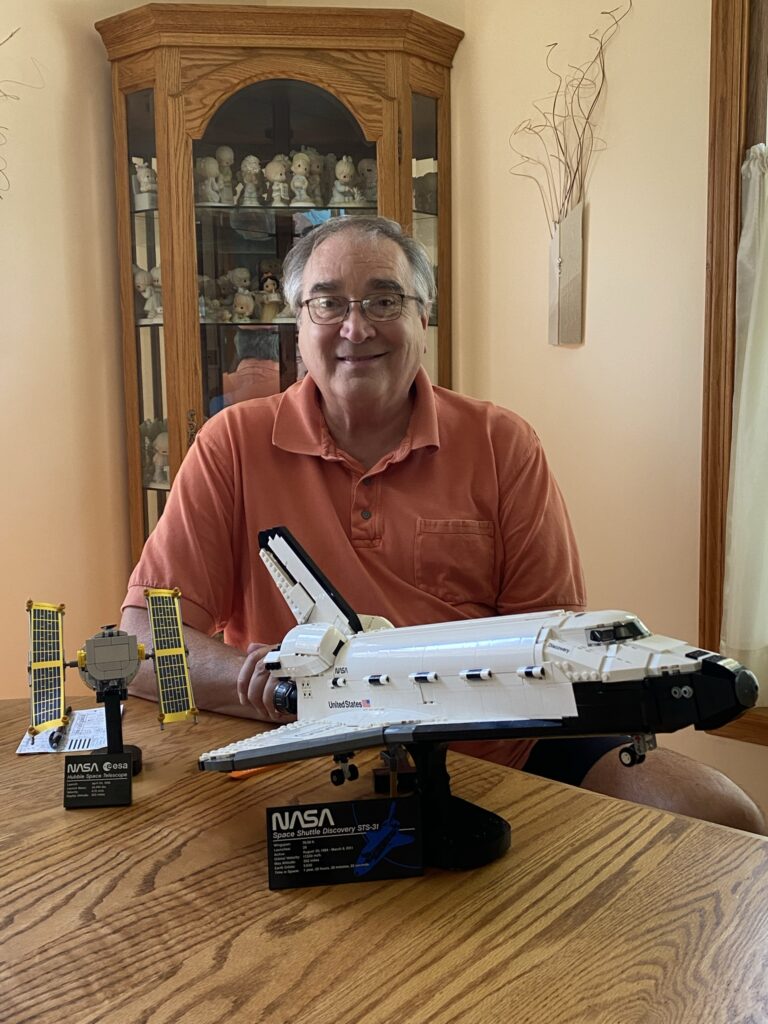
I reminded the group that the Hubble Space Telescope was down for a little over a month when one of its computers failed. NASA successfully restored science by using one of the backup computers but Hubble is getting old and there will be no more servicing missions to it. That makes launching the James Webb Space Telescope all the more important. Webb was to launch on Halloween this year, but excessive vibrations in the fairings of the Ariane 5 rocket has caused some concerns. Engineers have redesigned the fairings and are requiring that Ariane 5 launch at least twice with the new ones before risking Webb. On the afternoon of our meeting, the Ariane 5 launched with the first successful use of the new fairings. Because we need one more successful launch, Webb will probably be delayed until the second half of November this year. I’ll definitely have my “lucky” peanuts out for that rocket launch.
Battle of the Billionaires
Our first topic was that July 2021 was the month of billionaires in space. There is an estimated 3000 billionaires in the world as of 2020, who would have thought that Richard Branson and Jeff Bezos would both fly into space. Jeff Bezos announced he was going to fly on the first manned New Shepard capsule on the 52nd anniversary of the Apollo 11 moon landing, July 20, 2021. Of course, Richard Branson moved himself up a couple of flights and flew into space on his SpaceShipOne space plane on July 11. Branson’s space plane carried 6 people, 2 pilots and 4 Virgin Galactic employees (including Branson) and Bezos’s New Shepard capsule carried 4 people including Bezos and his younger brother Mark, Wally Funk, age 82, and Oliver Daemon, age 18. That made for 10 sub-orbital trips into space in July. There is a good site called SuperCluster that has a great database listing all the people that have gone into space. The count stands at 590. For some reason SuperCluster skipped #275, so their database actually says 591. This count includes anyone who has exceeded the 50 miles US Air Force criterion and the 3 rookie astronauts that lost their life in the Challenger explosion.
With the 10 sub-orbital people in July, the count for People in Space for 2021 is up to 22. You can see my monthly update on the status of the current MASS Prize on MASScosmos.org and follow my monthly blog on what my current guess for the number of people going into space during 2021.
As I said, Richard Branson was first to go into space by flying in his sub-orbital space plane. This was Virgin Galactic’s (VG) fourth manned flight. The carrier plane, VMS Eve, carried VSS Unity to a height of 45,000 ft before dropping it for a one minute powered flight. Unity climbed to a height of 53 miles (86 km) and landed after 12 minutes later back at SpacePort America in New Mexico. Here are some of Branson’s comments on his experience at the start of an Angry Astronaut video. VG has sold about 600 tickets at $250,000 apiece. For that price, you get 4 minutes of weightlessness. Elon Musk was there to wish him luck. VG says there will be a free lottery for some tickets on SpaceShipOne. The space plane is old school in that 2 pilots are required to manual control the craft and land it on a runway. Remember, the weightless feeling is during the time you are in free-fall. Both ascending after the rocket motor cuts off and descending until the craft begins to slow due to air friction. Gravity is still 9.4 m/s^2 at 100 km altitude which is only slightly less than the sea-level value of 9.8 m/s^2. Two more flights of SpaceShipOne are planned before going fully commercial. The first will be another with VG employees and the second a paying flight with Italian Air Force personnel.
Next up was Jeff Bezos, he rode the first manned flight of his New Shepard capsule and rocket. The flight set the record for the oldest, Wally Funk at 82, who was one of the Mercury 13 female pilots that performed all the same tests as the male Mercury astronauts but NASA never picked them to fly, and the youngest, Oliver Daemon at 18, who is the son of a Dutch venture capital CEO. Oliver paid for his flight and he was a substitute for the person who won the Blue Origin auction. The winner of the auction contributed $28 million to a charity to fly on the first flight but said he had a scheduling conflict and couldn’t make the flight. The previous youngest person in space, was cosmonaut Gherman Titov, who in 1961 flew just before his 26th birthday.
The New Shepard launched from Bezos’ ranch near Van Horn, Texas. It rose to 66.4 mi (107 km) with a top speed of 2233 mph for the 10 minute and 10 second trip before landing on parachutes. Van Horn is a small town, just a dot on the map along Interstate 10 between El Paso and San Antonio, with a population of less than 2000. You had to drive 40 miles from town to the reach the launch pad and its just another 30 miles to the Mexico border. It is the only town in Culberson County, which is 4000 square miles of arid scrublands and mountain ranges. The county includes Guadalupe Peak, the highest location in the Texas. Few of the 275 full time jobs have gone to locals and Bezos is not that popular. Blue Origin said they help bring in more than $1 million for the community in grants. The highway leading to the launch site was barricaded 11 miles from the spaceport’s perimeter, so there was no viewing for the locals. SpaceX’s launch site in Boca Chica, Texas, is in the farthest southeast section of the state and also borders on Mexico and the Gulf of Mexico. Musk also isn’t that popular with the locals because he has to close a road that leads to a recreation area on the Gulf every time he is testing or transporting his Starship rocket. Branson has a much different relationship with New Mexico. He persuaded the state to fund a $215 million spaceport for his SpaceShip takeoffs and landings.
If you want an in-depth comparison of Virgin Galactic (VG) and Blue Origin (BO) flights, the EveryDay astronaut has a good video contrasting the two sub-orbital missions and a good picture showing SpaceShipOne and New Shepard sizes relative to a Falcon9 booster. Falcon 9 makes the New Shepard rocket look tiny. Remember that SpaceX’s new rocket, Starship, will be 3 times the diameter of Falcon 9 and the Super Heavy booster will be as tall as the entire Falcon 9. Then put the 50 meter Starship second stage on top of the 70 meter Super Heavy.
I asked the MASS members which sub-orbital flight they would prefer to experience. Dean, Phil and Hank said VG. Keith said BO. I said either was ok with me. VG seemed to get the popularity nod because it was safer with the pilots and runway landing. In reality, VG has had an accident that killed one of the pilots when he accidently enabled the rotation of the rear stabilizers while the plane was still accelerating under power in the atmosphere. Sometimes full computer control, like the New Shepard capsule, is the safest, but I know computers can do really dumb things too.
Next up in manned launches, is the private Dragon Inspiration4 flight on Sept 15. There will be a crew of 4 and Hayley Arceneaux will set the record for the youngest American to orbit the earth at age 29. Beth has had another crew member of Inspiration4, Sian Proctor, on her podcast as part of the Sensoria Mars analog mission in Hawaii (episodes 88 & 108).
Mankind’s time-in-space has been going at a record clip during 2021. We have already exceeded the total time for 2020 on July 20 of this year. Space tourism will only add to this record time in space. Here’s a little background on space tourism. 20 years ago NASA clashed with Russia on the first space tourist, California businessman, Dennis Tito, who paid $20 million to visit ISS on a Soyuz for a week ending on May 6, 2001. 7 more tourist flights followed on Soyuz. Scott Manley has a nice 10 minute video describing the past and upcoming space tourist missions. He talks about the suborbital, Virgin Galactic and Blue Origin missions, and the orbital ones of Inspiration4, Soyuz MS-19, with a Russian actress and her director (Oct 5), Soyuz MS-20, with Japanese investor who is also booked on a SpaceX StarShip around the moon (Dec 8) and Axiom’s AX-1 4 person mission on Dragon (Jan 2022). Axiom has booked 3 more flights on Dragon with SpaceX and NASA. They are also planning to put their first module on ISS in late 2024. That will be good thing because it will increase the number of International Docking Adaptors (IDAs) from the current 2 to 3. Right now, IDA’s are limiting the flights of Starliners and Dragon crew and cargo capsules.
This Fall there are going to be 2 TV programs, “Space Hero” and “Who Wants to be an Astronaut?” Both programs plan to give away a seat on an Axiom mission to space. There never has been so many companies involved with space, exciting times!
Our last topic concerning the sub-orbital and tourism flights was “Are these space tourists astronauts?” First there is the issue of the height. The US Air Force uses a height of 50 miles (80km) for its astronaut criterion but others use the International standard of the Karman Line at 62 miles (100km). Theodore von Karman actually didn’t specify 100km, he was just defining the height at which an artificial satellite could orbit the earth. In a circular orbit the height is greater than 100 km and in an elliptical orbit, the lowest point of the orbit (periapsis) can be as low as 80 km. Jonathan McDowell has a great site defining orbits and astronautics and astrophysics terminology. He also has suggested using the term “spacer” for the relatively untrained space tourists. Scott Manley has a good video with his opinion on whether all these new space tourists are astronauts.
NASA topics
We moved on to new topics under the heading of NASA. First up was the upcoming redo of the unmanned Starliner capsule by Boeing. It was scheduled to launch on July 30 but trouble with the Russian Nauka module docking with ISS has delayed it to August 3 at the earliest. Weather was only a 40% “go” on July 30, so it might not have occurred anyway. Boeing’s first attempt, OFT-1, failed to dock to ISS way back in December of 2019. Remember, SpaceX launched their first person on Dragon to the ISS on May 27, 2020 and plans their third long duration crewed launch this October 31, 2021. Starliner which is NASA’s other Commercial Crew capsule has yet to fly people, even though Boeing received $4.8 billion compared to SpaceX’s $3.1 billion in funding. Starliner seats are expected to cost NASA $90 million, compared to a seat on Crew Dragon only $55 million. I’m not sure the plan of using competition in the Commercial Crew program was that successful. NASA seems to be rewarding a very late and overpriced solution in the Starliner. But it is good that the US will eventually have 2 independent methods to get astronauts to the ISS. The OFT-2 Starliner mission is expected to spend 6 days on orbit and will carry 200 kg of supplies to ISS. There is a slight possibility that the CFT manned mission will be launched this year with a crew of 3, including Barry Wilmore, Mike Fincke and Nicole Mann. Following that test manned mission would be the first operational flight during April 2022, with Sunita Williams, Josh Cassada, Jeanette Epps and Koichi Wakata of JAXA. The OFT-2 capsule will again contain Rosie the Rocketeer in it. Boeing has 2 Starliner capsules each certified for 10 uses. OFT-2 will use the second capsule. OFT-1 and the crewed CFT mission will use the first capsule. The Starliner will not stay attached to ISS very long, undocking is scheduled only a few days after it meets up with ISS. NASA has to free up that docking adapter for the next Dragon cargo mission.
Another NASA topic was the status of the Human Landing System (HLS) for the Artemis program. Just this afternoon, July 30, the General Accounting Office (GAO) denied the validity of the protests of Blue Origin and Dynetics. The GAO statement said that NASA did not violate procurement law or regulation when it decided on one award to SpaceX for use of the Starship as the manned lunar lander, evaluation of all 3 proposals was reasonable. Now NASA can establish a timeline for the first crewed landing on the moon. A timeline update on Artemis should be forthcoming. Before awarding SpaceX the $2.9 billion, NASA had given out $135 million to SpaceX, $253 million to Dynetics and $579 million to Blue Origin to mature their designs. Blue Origin’s proposal for the full Blue Moon lander development was $5.99 billion and Dynetics’ Alpaca lander was to cost $8.5 billion.
Bezos had recently sent a letter to NASA Administrator Bill Nelson pledging that Jeff would pay for the first $2 billion in development costs for Blue Moon, if, and that is a big “if” NASA would pick Blue Moon as the second lander to be funded for development. What kind of fair competition is that? If your company has a billionaire on it, you can chip in a few billion dollars. Musk is putting billions of his own money into Starship but the difference is that he is doing that whether or not NASA selects him. Here is the Angry Astronaut’s video on the $2 billion offer.
Congress was also doing some shady antics with HLS too. They were going to allocate $10 billion from an unrelated infrastructure bill. The money was predicated on NASA selecting a second HLS lander and wording indicated that it should be the Blue Moon lander. Bill Nelson says SpaceX’s bid is fixed price at $2.9 billion and they think it will cost them $6 billion, so Musk is chipping in $3 billion of his own money. Any second HLS contract ought to have that stipulation too. Nelson also acknowledged that Artemis will cost $86 billion thru 2025. I think that includes SLS/Orion and HLS. HLS has been a little corrupt for a while. Remember a couple of years back when Doug Lovarro had to step down as head of the Human Exploration Directorship because he was trying to get Boeing to lower their price on their entry into HLS. Boeing was eventually eliminated. It’s a little strange when both Rand Paul and Bernie Sanders agree in their opposition of funding a “Bezos Bailout”.
NASA proposed budget for FY 2022 is also working its way through Congress. The $24.8 billion proposal is a 7% increase over FY 2021. In the proposal, Artemis gets $6.88 billion, SLS $4.4 billion, Lunar Gateway $2.39 billion, HLS $1.2 billion, Operations (ISS support) $4 billion, and the biggest chuck goes to Science $7.93 billion. The Science pot is divided between Planetary Science $3.2 billion, new Earth studies $2.25 billion. The missions supported by Planetary Science money include, the Mars Sample Return, Europa Clipper, NEO Surveyor (searching for near earth asteroids), Dragonfly, (a quad copter destined for Saturn’s moon, Titan), space telescopes like the Roman Space Telescope and plutonium-238 production for nuclear power devices like the Curiosity and Perseverance rovers on Mars. Two new Discovery Class missions for Venus are also included as well as dozens of lunar instruments and tech demos. Every operating mission is funded. Cancelation of the SOFIA, an infra-red telescope plane, might be the only Congressional fight. Here is Casey Dreier opinion on the proposed NASA budget. Recently, the House has recommended $25.04 billion for NASA, $240 million more than President Biden’s request. The House includes $110 million for a Nuclear Thermal Propulsion (NTP) rocket and $80 million for the design of a flight demonstration project of NTP. NTP, which is twice as efficient as chemical rockets, could really open up the Solar System to exploration.
Some strange riders mainly intended to help certain states have been proposed but fortunately not included in the final NASA budget. Alabama Representative Aderholt (R-AL) proposed quick development of a new second stage for SLS and that NASA must use this version of SLS for the second HLS provider. A Mississippi lawmaker was making SLS perform numerous ground tests that of course would have to be done in his district as the Stennis Space Center. Narrow interests like this will only inflate SLS costs more. I’d like to see SLS capability be upgraded only after the first few launches of the Block 1 version achieve their objectives. Money shouldn’t be sunk into the Block 1B with its improved second stage until a case can be made for the need of a cargo SLS variant.
Next up was Juno’s close flyby of Jupiter’s moon Ganymede. Juno was able to take pictures from only 645 miles above the surface as it traveled at 40,000 mph. Some pictures are of the nightside of Ganymede lit only by Jupiter and able to show 1 km sized objects. Scientists used the flyby to shrink Juno’s orbital period from 53 days to 43 days. This sets up a flyby of Europa in September 2022 and Io in 2023 and 2024. The probe stayed in its highly elliptical orbit because of concern about its thrusters and need to minimize time in Jupiter’s radiation belt. This was Juno’s 33rd close pass of Jupiter. Ganymede at 1637 miles is the largest moon in the solar system. It is 1.08 times the diameter of Mercury and 1.51 times our Moon. It is the only moon with a magnetic field which means it has a liquid core, which maybe a saltwater buried ocean containing more water than the Earth. This is the closest pass to Ganymede in 21 years since the Galileo probe in 2000. Pictures show the cratered icy surface, with long stripe-like grooves and ridges which could be tectonic faults. Here is a 4 minute video of Ganymede and Jupiter close approach with music. During ISDC 2021, Juno’s chief scientist, Scott Bolton, discussed some of the phenomenal pictures that have come from Juno. The Juno pictures were made by citizen scientists using their own equipment. You only need to watch the video from 2:00:00 to 2:33:00.
We talked a little about the upcoming Double Asteroid Re-direction Test mission (DART). The June 2021 issue of the Planetary Society magazine had a good article describing the mission. The launch window opens on November 24, 2021. It will launch on a Falcon 9 rocket. The asteroid that the probe is heading to, is a binary asteroid, with the main body, Didymos (780 m diameter) circled by a moon called Dimorphos (160 m). DART is a washing machine sized probe which will impact the smaller body Dimorphos at 6.6 km/sec (14,800 mph). The asteroid moon weighs 5 million mt and orbits every 11.9 hours. The impact should change the orbit to 11.8 hours (10 minutes slower). Astronomers can measure the orbit by observing the dimming and brightening period. The asteroid is so far away it appears as only a single pixel in telescopes. The first asteroid was discovered in 1801 and named Ceres. In 2005 the US Congress mandated that NASA find 90% of the 140m of larger Near Earth Objects (NEOs). The 140 m object could be “city killer” if it impacted the wrong place on Earth. So far only 40% of object of this size have been found. A new probe called NEO Surveyor, an infrared space telescope dedicated to the search for NEOs, has just been funded by NASA for launch in 2026. An asteroid only 20 m in diameter, like Chelyabinsk, can cause considerable damage. Tunguska, which exploded above Siberia in 1908, was a 50-80m object that leveled 770 square miles of forest. The asteroid sampled by the Osiris-Rex mission, Bennu, is 500 m in diameter. The asteroid or comet that ended the dinosaurs is believed to be a 10 km object.
The last of the NASA topics was the recent trouble with Hubble. The telescope was down for over a month due to the failure of one of its computers. Fortunately, NASA was able to switch to a backup computer and re-establish its science on July 18, 2021. Hubble is really getting old. It’s last servicing was in May 2009. Servicing is no longer possible now that the Shuttle has been retired. Hopefully, we’ll get the JWST launched soon.
ISS
Russia has been threatening to leave the ISS. Now, they are launching a much delayed module called Nauka (Russian for Science, and pronounced Ny-oh-ka) to the ISS. The module could have been the start of a new Russian space station. Russia is upset about the sanctions imposed after their invasion of Crimea and some of their satellite launches have had to be postponed because they can’t obtain the needed computer chips. Current agreement between the US and Russia is for ISS operation through 2024. Nauka construction began in 1995. In 2013 the module was returned to the factory after metal chips were found in its fuel system. It can generate oxygen for 6 people and regenerate water from urine. It also has a toilet and room for a third crew member’s sleeping quarters. It will also support the new European Robotic Arm. It was launched on July 21, 2021 on a Proton rocket. At 44,860 lbs. (20.2 mt), it is the ISS’s heaviest module and was meant to be a backup to the Zarya module. On Friday, July 26, Russia undocked their Pirs module, which was first attached to ISS in 2001. They used a Soyuz supply capsule to send Pirs into a controlled burn-up in the atmosphere. Pirs was the first module ever deactivated on ISS. Docking with ISS was delayed until July 29 because the Nauka thrusters were having a problem. After docking, the Nauka thrusters continued to fire and tilted the over 900,000 lb space station by up to 45 degrees from its proper attitude. Fortunately, Russian controllers used thrusters on other modules to get the ISS back into its proper orientation. Could Nauka be Russia’s Trojan Horse, meant to sabotage the ISS? That is just one of my wild theories. Although the US has said there was no damage caused to the ISS, we did have to cancel our Starliner launch on July 30. Starliner is now scheduled for August 3. More recently I saw this quote from NASA that the Nauka event was even more serious that first reported, “Reports of ISS only being 45 degrees out were premature,” Zebulon Scoville, a NASA ISS flight director, tweeted July 30. “We proceeded to do headstands and cartwheels. Olympic judges would be proud.”
Axiom has contracted with SpaceX for 3 more Dragon missions to the ISS. Besides Dragon missions, Axiom intends to start adding modules to the ISS for the eventual establishment of its own Commercial Space Station. The first new module is going up to ISS in 2024. Axiom’s first Dragon mission is called, AX1, and is scheduled for January 2022. It will have a 4 man crew and spend 8 days docked to ISS. AX2 is also scheduled for 2022 and AX3 and AX4 in 2023. There is an 8-part TV show coming this Fall that will award the winner with a seat on AX2. The Discovery show is titled, “Who Wants to be an Astronaut” and will the award the winner an 8-day trip to ISS. A later show called, “Space Hero”, will work with a seat on an Axiom flight in 2023.
The first two new roll-out solar panels have been installed on the ISS. Astronauts rolled the first one out on Sunday, June 20, 2021. ISS’s 8 old arrays originally produced 30 kw each for a total power of 250 kw. But now the arrays, the oldest dating back to 2000, only produce 160 kw. The 6 new roll-out arrays are being placed on top of the old ones and will generate 120 kw. The new ones (750 lbs and 20 ft by 60 ft) are 30% efficient versus the 14% efficiency of the old ones. They will generate 20 kw each, about the same amount of power as the old ones even though only half their size. The un-shadowed old arrays will generate 95 kw, giving the ISS a total power of 215 kw, an increase of a third. Second array was installed on Friday June 25. The old heritage arrays had these specs – 32kw, 2400#, 115ft x 30ft. The new IROSA arrays are 23kw, 750#, 63ft x 20ft. The Power and Propulsion Element (PPE) of the Lunar Gateway will also use the same roll-out design for its arrays, which will be rated at 32kw, 950#, 60ft x 32ft.
China
The Shenzhou-12 mission is China’s first human flight in 5 years. The 3 taikonauts launched on June 16 and plan to spend 3 months attached to their new space station. This will be China’s longest manned space mission. They have had 6 previous manned missions, with the first in 2003. Russia says they will send cosmonauts to the Tiangong 3 space station, but the Chinese space station is in an orbit that Russian launch facilities can not reach due to its inclination. I’m not sure where the Russians will launch from.
With all the recent Chinese accomplishments, landing on the far side of moon, performing a lunar sample return, landing a rover on Mars on their first Mars mission, putting up the first module of a new space station, I think the new “space race” is going to be between China and the US. We better spend our money wisely and keep on a steady course based on engineering and scientific input, not politics and wasteful “pork” projects. I think the SLS is our best chance to send people to the moon in the short term but we have to be careful of its cost. Investing too much money in the SLS if it gets superseded by a new rocket like SpaceX’s Starship, could drain our resources in other technological areas.
China and Russia have shared a few details of their new moon base plans. The ILRS (International Lunar Research Station) will consist of a space station in lunar orbit, a surface base with a set of mobile rovers and hopping robots. ESA, Thailand, UAE and Saudi Arabia might join. The Reconnaissance phase is to begin in 2021. By 2025, a moon base site will be chosen and construction to follow between 2026 and 2035. ILRS will become operational in 2036 to support scientific study of the moon and human exploration. There are no plans for astronauts on ILRS within the next decade.
The US’s plan for the moon is the Artemis program. Our current date for the first manned landing is 2024 but we’ll see if NASA updates it when they publish their new timeline with SpaceX’s lunar Starship as the HLS choice. Along with the Artemis program, we also have the Artemis Accords that broadly define how countries and organizations should conduct themselves in space exploration. Brazil recently joined the Artemis Accords.
China also has the goal of putting a man on Mars by 2033 but US’s goal date is late 2030s. I don’t think it will be good for us if we are second in sending people to Mars. MRO orbiting Mars gives more information where China’s Mars rover moving than China does. There are reports that China might be trying to duplicate SpaceX’s Starship.
Mars
The Ingenuity helicopter has flown its 10th flight, flying a distance of 95m (310 ft) past the area called Raised Ridges. This flight was the most complex with 10 different waypoints and a new record height of 12m (40 ft). It is now at its 7th airfield. Here is a short video along with some pictures from Percy. Rather than describing all the flights, here is Ingenuity’s flight log. The helicopter has exceeded 1 mile in total flight distance.
The rover is getting ready to take its first sample in early August of the “paver stones” that cover the crater floor. Percy is at the “Crater Floor Fractured Rough” location. Scientists aren’t sure if the rocks are igneous or sedimentary. Scientists will first use an abrader tool to scratch down a centimeter and study the composition of the rock. Rover has so far driven a total of 1 kilometer. It landed at the “Octavia E Butler Landing Site” and has driven south to the “Crater Floor Fractured Rough” location. It plans to take some samples at the “Raised Ridges” area that was scouted by Ingenuity and then proceed as far as the “Seitah” location before heading back to its landing location and proceeding north and west to the Three Forks location in the river delta. Percy has 43 tubes with 5 witness ones to check for contamination. Here is the home site of Percy mission. It shows as of August 2, Percy is in Mars Sol number 161 (161 Mars days since landing) and the July 30 weather report was a high temperature of -16 degrees F and a low of -113 degrees F.
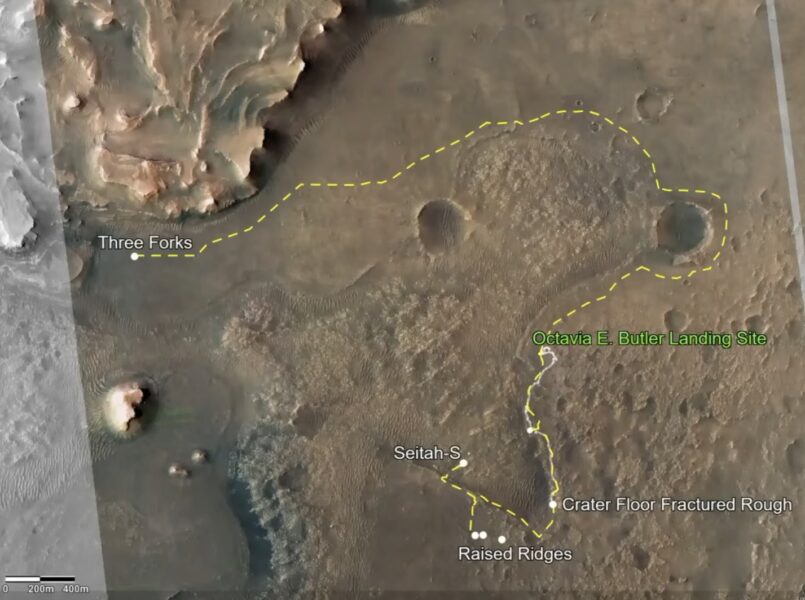
SpaceX
SpaceX just got their 3rd landing barge, “A Shortfall of Gravitas”. This one travels under its own power much better than the previous ones, “Just read the instructions” and “Of course I still love you”. “Of course I still love you” moved thru Panama Canal to the Pacific Ocean so it can catch boosters launched from Vandenburg in California. SpaceX plans to start a new campaign of launching polar orbiting StarLink satellites from Vandenburg beginning in August 2021.
The third prototype of the Super Heavy booster, B3, just had its first test fire of 3 Raptor engines after undergoing cryo tests. The fourth booster, B4, will be the booster that carries the Starship, S20, into orbit.
Falcon Heavy to launch Europa Clipper for a bargain price, not the SLS. The planned launch date is in October 2024. The $4.25 billion mission will spend much of the decade flying to Jupiter, arriving in April 2030. It will make 44 flybys of Europa. Cost of the Falcon Heavy launch will be $178 million which saves NASA about $2 billion. SLS would have gotten the mission there in 4 years, rather than the almost 6 years with Falcon Heavy. Other than cost, the decision process was concerned with uncertainty on SLS’s availability because it is needed for Artemis missions and the shaking of the rocket from the solid core boosters on the first stage. SLS also would have needed development of a new more powerful second stage to accomplish the 4 year travel time.
On the topic of satellites starting to impact astronomers ability to observe from the Earth, SpaceX has put a sun shade that has dimmed their satellites to less than naked-eye brightness. This will help the issue but not resolve it completely. Higher orbiting satellites like OneWeb, will be more of a problem because they are in sunlight longer after sunset. OneWeb lowered the number of planned satellites after they emerged from bankruptcy. But now China plans their own high 13,000 satellite constellation, so the overall outlook is just as bleak as before. Finally, Amazon’s Kuiper satellites will be the fourth large constellation of lower orbit communication satellites. You can understand why an astronomer doing spectroscopy on a faint galaxy will have his data ruined by a quick flash of solar energy reflecting off a satellite entering the telescope’s field of view. One recent scientific paper had to be retracted after they announced a flare in a distant galaxy because the flare was due to a reflection off an old Russian rocket body. Part of the solution could be sharing good coordinate information for the active satellites, making the satellites as dim as possible and removing space junk from orbit.
UFOs
I’ve recently waffled on the topic of UFOs. A few weeks back I watched a “60-minutes” show where several Navy pilots described what they had seen, both on radar and with their eyes. They described a “tic-tac” shaped object with incredible acceleration that could travel in air and underwater. One pilot also described how he saw the ocean disturbed around the object too. Then I saw a video with Mick West, a YouTuber who has debunked many of the UFO videos. His description of how radar and infrared sensors can demonstrate overload and how the movement of the sensor can give the object in the video the appearance of motion. After watching his response, I’m back being a strong skeptic that the “tic-tac”s are physical objects either from other countries or from other planets. Bill Nelson, NASA Administrator, even weighed in on the controversy by getting NASA personnel involved with the analysis. Here is a long video with Mick West, you only need to watch the first 8 minutes to get a feel for his opinion. Brian Keating, who hosts the webcast, is the chief scientist behind the BICEP experiment at the south pole that erroneous announced evidence for the Big Bang in the microwave background radiation. That is why he has his book titled, “Losing the Nobel Prize” in the background. Here is a 3-minute video showing and debunking 3 of the recently released UFO video’s.
We finished the meeting at about 10:10 PM. With our new start time of 7:30 PM, that kept the meeting close to a relatively short 2 1/2 hours. The crew left me with way too much snacks, but if I pace myself, I’m sure I’ll do them justice.
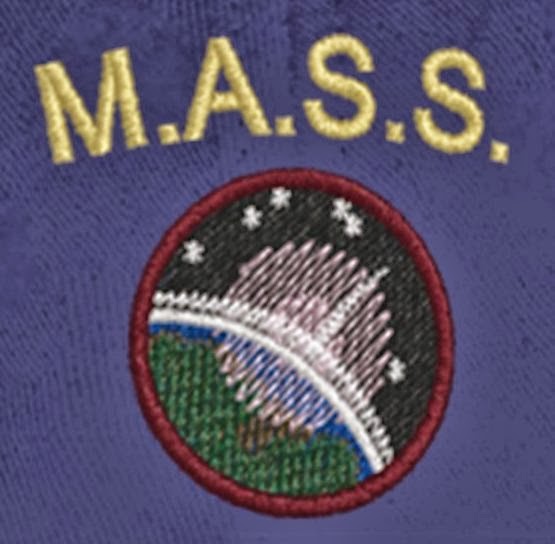
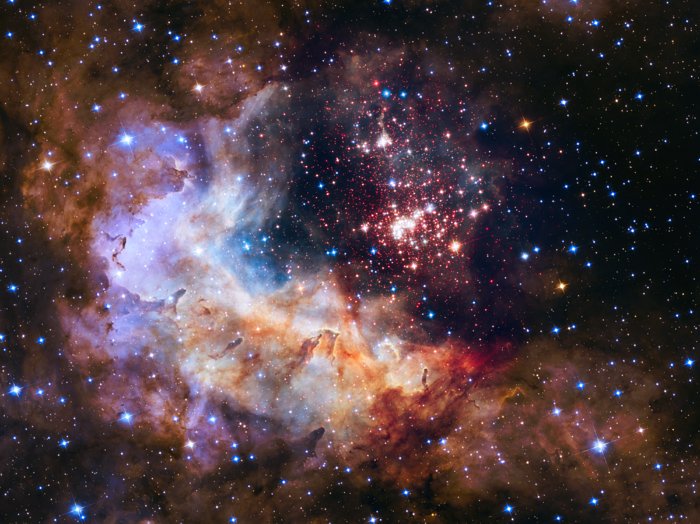
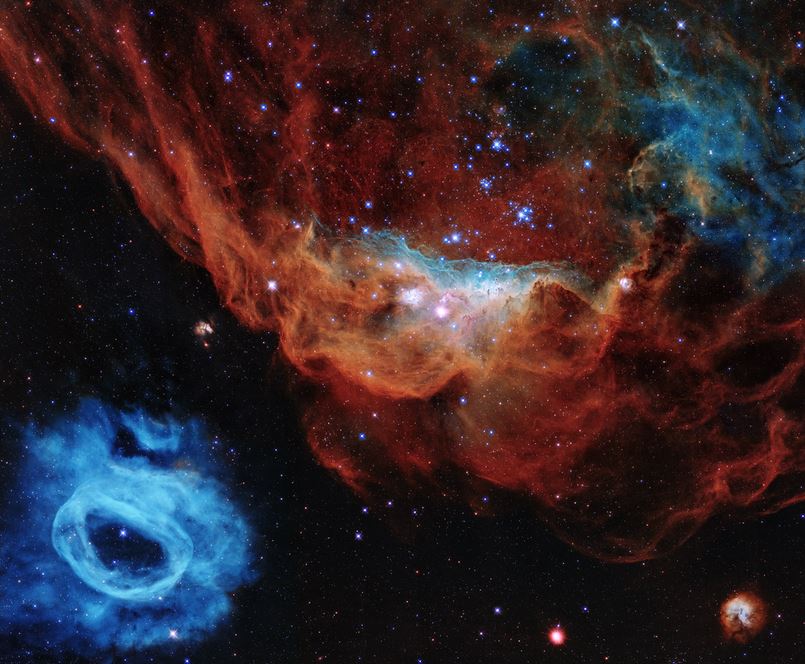
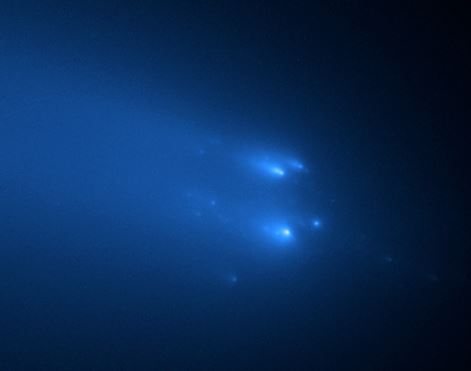

Recent Comments